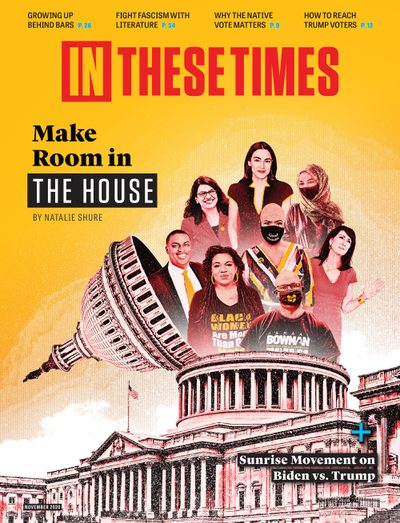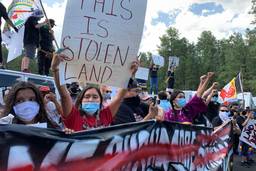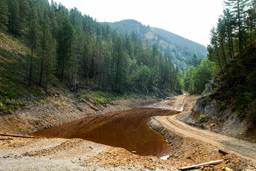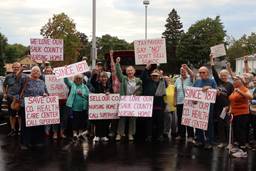Native Voters Could Swing the 2020 Election—If They’re Able to Vote
Menominee tribal citizens are working to make Native votes count in Wisconsin
Stephanie Woodard

This article is part of The Wisconsin Idea, an investigative reporting initiative focused on rural Wisconsin.
MENOMINEE COUNTY, Wis. — The power of Native voters to decide the 2020 presidential election cannot be overstated, U.S. Rep. Sharice Davids (D-Kan.), a Ho-Chunk Nation citizen, told the Democratic Party in August. States with sizable Indigenous populations — Arizona, Minnesota and others — are in play, Davids said. Even Wisconsin’s small Native voting-age population could impact the race for the White House, according to Davids. President Donald Trump won Wisconsin in 2016 by just 0.77%, while Indigenous voters make up about 1.5% of the state’s electorate, according to the National Congress of American Indians (NCAI).
To get people to the polls, a grassroots advocacy group called Menikanaehkem, based on the 235,000-acre reservation of the federally recognized Menominee Indian Tribe of Wisconsin, is working with the Native-organizing arm of Wisconsin Conservation Voters on digital ways to communicate with fellow tribal members about this year’s issues and voting procedures. The group, whose name is pronounced men-ee-KAHN-ah-kem (translated as “community rebuilders”), supports the well-being of Menominees living among the green hills, rushing rivers and sparkling waterfalls of northeastern Wisconsin.
During Wisconsin’s April primary election, in-person voters faced long lines and the risk of Covid-19 infection to cast their ballots. To prevent this from recurring, Menikanaehkem is encouraging use of the absentee, or mail-in, option — as is Menominee County, whose borders correspond with the reservation’s and which handles national elections there.
While the Menominee reservation, according to Menikanaehkem Executive Director Guy Reiter, enjoys relatively good mail service, postal service in many Native American communities, like access to physical polling places, has long been unreliable and inequitable. Postal slow-downs during mail-in voting would likely hit these communities particularly hard.
A drop in Native voter turnout could have consequences across the country. Native Americans are more involved and influential in U.S. elections than is commonly understood—fielding scores of candidates for state and national office, running presidential candidate forums and managing energetic get-out-the-vote campaigns. With around 3.7 million Native people of voting age concentrated in Western states — and this voting-age population accounting for up to 11% of the electorate in New Mexico, 12% in Oklahoma and 17% in Alaska, as tabulated by NCAI — Native voters can dramatically shape election results. Tribal backing has helped many candidates, among them Lt. Gov Peggy Flanagan (D-Minn.), Sen. Jon Tester (D-Mont.), Sen. Maria Cantwell (D-Wash.), former Sen. Mark Begich (D-Alaska), former Sen. Heidi Heitkamp (D-N.D.), former Sen. Tim Johnson (D-S.D.) and former Sen. Tom Daschle (D-S.D.).
To make sure every Menominee vote counts this year, Wisconsin Conservation Voters is helping Menikanaehkem and representatives of other tribal nations reach out to their communities through text messages, social media, email, and virtual town halls. These digital techniques have become essential to campaigns in the pandemic era, as formerly routine meetings and canvassing efforts become potentially hazardous. Reiter explains: It’s hard to be a community organizer if you can’t be in the community.
Hurdles to Native voting
Since being granted U.S. citizenship and suffrage in 1924, Native people have brought scores of lawsuits to exercise their voting rights. Some Native voters still face harassment, distant and hard-to-access precinct offices, reduced or unpredictable voting times, and the refusal of poll workers to accept the kinds of personal identification they ordinarily carry.
The pandemic adds new barriers: This year, because of Covid-19, many voters will rely on mail-in ballots to cast their votes. But as In These Times has reported, many tribal citizens do not have home mail delivery but rely on P.O. boxes or general delivery in distant post offices. On some reservations, these are small contract facilities with inconsistent service and limited hours.
A recent study conducted around the Navajo Nation offers a warning. Native voting rights group Four Directions sent test mailings from towns in and around the reservation and found that while mail from some majority-white communities typically took a day to get to the county polling place, Navajo mail took as many as 10 days.
Four Directions is assisting Navajo plaintiffs with a federal voting-rights lawsuit that features the mail study. The lawsuit asks Arizona to allow additional time for Navajo mail-in ballots to be counted.
Bret Healy, a consultant for the group, puts it this way: “[Mail service on the reservation] was bad before the pandemic, and any slowdown or confusion makes it worse.” Healy predicts a “catastrophic drop” in voter turnout across Indian country if such problems aren’t fixed.
Meanwhile, in the Dakotas, the Standing Rock Sioux Tribe and the Lakota People’s Law Project recently joined Sen. Tom Udall (D-N.M.) and U.S. House Assistant Speaker Ben Ray Luján (D-N.M.) to work on passage of the Native American Voting Rights Act. The bill would mandate accessible polling places, increased voter registration, better access to federal election monitors and other improvements for Native communities.
Saving the “good place”
According to Reiter, many Native voters are more driven by issues than candidates and parties. They are always interested in health and education issues, he says, and have grave concerns about challenges to tribal sovereignty and harm to land, water and sacred places. As in the Standing Rock Sioux Tribe’s fight against the Dakota Access Pipeline (DAPL), Native people are often the spearpoint in environmental clashes with outcomes that affect millions of people.
In addition to pushing for pipelines, such as DAPL and Keystone XL, to be built through or near Native homelands, the Trump administration has diminished federal protection for vast areas of natural beauty and tribal cultural meaning, including Bears Ears National Monument in Utah. A major worry in northeastern Wisconsin is the Back Forty Mine, an open-pit metals mine proposed for just over the border in Michigan. Wisconsin’s name comes from a Menominee expression meaning “a good place to live,” and Menominees say the mine will degrade that good place. They predict damage to centuries-old garden sites, ceremonial places and burial mounds.
According to Earthjustice, the law firm representing the tribe in litigation against the mine, its harms would go much farther. Toxic acid drainage from the mine will contaminate the Menominee River, the firm says. The river flows into Lake Michigan, one of the Great Lakes, which together contain one-fifth of the planet’s surface freshwater. Chicago, Milwaukee and other cities and towns downstream from the proposed mine pull their drinking water from this gigantic continental reservoir.
Also worrisome for the Menominees is exploratory drilling underway for a metals mine in the headwaters of the Wolf River. This Wisconsin National Scenic River arises north of the Menominee Reservation and flows through it.
Though the challenges are huge, Reiter says, his people and other tribal citizens will persist in fighting to protect the earth. “As long as this earth is here, as long as we’re here, we’ll never give up,” he says. To vote in a way that supports that effort, “You have to do your homework.” Though Democrats have historically been cooperative about environmental issues, so have some Republicans, Reiter says — so he is producing paper and digital election scorecards to chart and clarify candidates’ positions on issues important to Indigenous people.
Leading from tradition
Menominee political activism exists in the context of numerous heritage-based projects and businesses. “Our work is spirit-led and comes from our land-based lifeways,” says tribal member Rachel Fernandez. For a century and a half, the tribe has used traditional principles to harvest wood sustainably and profitably. The 145-year-old conservation group American Forests calls the Menominee woodland “one of the most historically significant working forests in the world.”
Menikanaehkem brings the same time-honored principals to bear in its other projects. Among them are food sovereignty and women’s leadership and empowerment, including midwifery and traditional birthing practices. The group’s solar-powered “tiny homes” shelter those who need time and space during life transitions.
Fernandez believes that getting the next generation of Menominee leaders interested in elections is also important and functions as part of preparing youngsters to carry their traditions into the future. “In these trying times,” she says, “we need to reflect on who we are, who our ancestors were and what they endured to ensure that we are here. In this way, we can …prepare for our descendants’ lives. We must be that good ancestor for them. When you stand in your truth, it sustains you.”
Despite the turmoil this year, Menominees are undeterred, Reiter says. His people have survived other crises, even other pandemics, even genocide. “That is a helluva strength,” he says. “We got this.
Stephanie Woodard is an award-winning human-rights reporter and author of American Apartheid: The Native American Struggle for Self-Determination and Inclusion.









